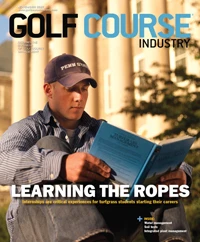Q While attending the U.S. Open Championship at Oakmont Country Club in June, I was disappointed to see the players so far forward on the teeing ground at the practice range. Why were they so far forward on the tee?
A To provide the competitors with the same practice conditions they would experience on the golf course, the USGA, in cooperation with the PGA Tour, has the players begin practicing at the back of the teeing ground on Monday. Throughout the week, they’re moved forward toward the front of the tee so the turf remains free from pedestrian traffic and divots and debris, and the same height of cut and turf density as the fairways.
This method allows the grounds staff to maintain and clean the turf without old divot scars and the soil mixes damaging or dulling the mower reel blades.
Q During a championship, I watched the grounds volunteers pick up old divots from the fairways each night and fill the scar with a dark material. What’s in the bottles and buckets, and why not use sand?
A Competitors have complained about playing a shot from sand-filled divots from the middle of the fairway. To them, it constitutes a penalty. So, to reduce these concerns and to provide a firmer and more reliable playing surface, the recommendation to host sites is to have the divot replacement mix be an equal combination of soil, sand and organic matter. Seed in the mixture only applies to certain turf types.
Once the mix is added, it’s tamped for firmness so players will have a level, firm and predictable shot response. Divot replacement is accomplished each evening so the mix remains dry and unaffected by the morning dew. Too much moisture can cause the mix to streak on the fairways and lessen reel sharpness.
Q What’s the repair strategy for a golf course after a heavy rain and an ensuing play delay during a championship?
A Repair depends on several factors: the amount of rain, the degree of damage to the course, the time it takes to recover and be ready for play, and if there’s lightning in the area, which will prolong the delay. Officials also need to determine if play can return without additional rules issues.
The repair procedure primarily focuses on the putting surfaces first, followed by: greenside bunkers, fairway bunkers, fairway landing zones and teeing grounds, where any standing or casual water might be present. When repairing for play, the grounds staff must be allowed ample time to finish the work without rushing and be in constant communication with the Rules staff.
Q When starting work so early in the morning and in the dark most times, is there any way to increase light so the grounds staff can see better?
A At The PGA Championship at Southern Hills Country Club, Russ Myers, CGCS, borrowed Department of Transportation lights to illuminate the golf course. However, after conducting one of his many television interviews, he noticed how bright the studio lights were. One lamp could light up several of the fairways close to the clubhouse, allowing all fairway mowing groups to start cutting long before sunrise.
Q All we heard during the week of the FedEx Championship at East Lake Golf Club was how bad putting green conditions were and that they were virtually unplayable. However, it didn’t appear to hurt Tiger Woods or the rest of the field. What was done to prepare the surfaces for play?
A First, Ralph Kepple, CGCS, his staff and the volunteers should be commended for their hard work. Second, the putting surfaces weren’t unplayable. Ralph and his team took all the correct steps to encourage healthy turfgrass growth.
All member, PGA Tour player and corporate play was halted before and during the practice rounds to reduce traffic stress. A fertility plan was implemented to strengthen and grow the turf, fill in any surface voids and withstand the stress from the competition. Fans were used to move stagnant air. Subsurface ventilation was initiated, and the height of cut was raised and reestablished to meet PGA Tour requirements. Solid front rollers for walk-mowers replaced grooved rollers to reduce damage to the turf through mechanical stresses. Cutting frequency was reduced compared to other golf major operations, and hand syringing and irrigation was employed. Light and frequent hand topdressing was used to smooth any surface blemishes to allow for a consistent ball roll and tracking. All potential hole location areas were reviewed and protected.
Most importantly, the PGA Tour players understood the difficult summer conditions, including record high temperatures, humidity and too much or not enough rain. These environmental factors, combined with the club’s difficult microenvironment (its close proximity to downtown Atlanta increases temperature and humidity) made growing a cool-season bentgrass turf extremely difficult. However, the end result was uniform conditions for all competitors, for which Ralph is to be commended.
This championship should help all golfers better understand that preparing a golf course to its highest level takes painstaking commitment, knowledge and dedication. Maybe they’ll even understand it’s the same daily routine for all golf course superintendents. GCI
Editor’s note: If you have questions about course set-up or maintenance related to golf tournaments or events, e-mail Tim Moraghan at tmoraghan11@comcast.net.
Tim Moraghan is principal of Aspire Golf Consulting in Long Valley, N.J. He can be reached at tmoraghan11@comcast.net or 908-635-7978.

Explore the November 2007 Issue
Check out more from this issue and find your next story to read.
Latest from Golf Course Industry
- Editor’s notebook: Green Start Academy 2024
- USGA focuses on inclusion, sustainability in 2024
- Greens with Envy 65: Carolina on our mind
- Five Iron Golf expands into Minnesota
- Global sports group 54 invests in Turfgrass
- Hawaii's Mauna Kea Golf Course announces reopening
- Georgia GCSA honors superintendent of the year
- Reel Turf Techs: Alex Tessman





